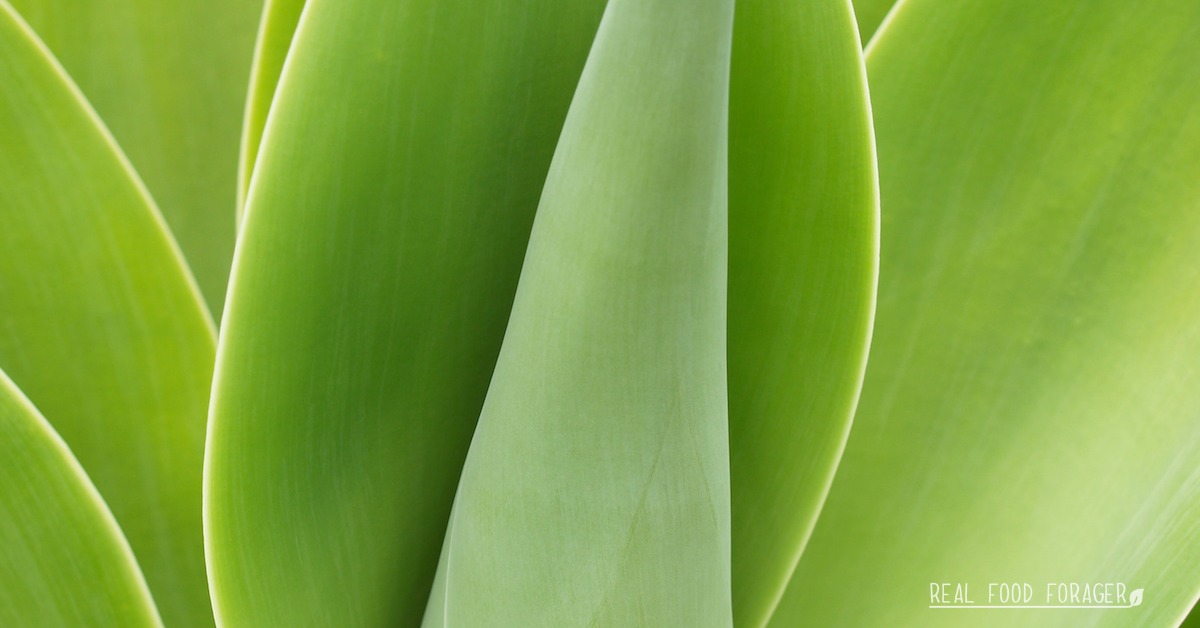
I’ve noticed that many people use agave in their recipes even though they are Real Foodies. I just think they may not have heard the truth about agave. Here’s why I never use agave.
For starters, the high levels of synthesized fructose in agave put people at risk for obesity, heart disease, arterial inflammation, high blood pressure and increased insulin resistance.
Agave was developed in the 1990’s and is made primarily in Mexico. There is really no such thing as agave nectar. The sweetener is made from the starchy part of the yucca or agave plant – the roots. Inulin, also a complex carbohydrate, makes up about 50% of the carbohydrate content of agave.
To produce so called agave nectar from the Agave Americana and Tequiliana plants requires heat, chemicals and processing. The leaves are cut off the plant after it has aged 7 to 14 years. Then the juice is expressed from the core of the agave. The juice is filtered, then heated, in order to hydrolyze the polysaccharides into simple sugars.
The filtered, hydrolyzed juice is concentrated to a syrupy liquid, slightly thinner than honey, from light colored to dark amber, depending on the degree of processing. (source)
It is a highly processed operation to convert the carbohydrates into a liquid nectar. This is done using caustic acids, clarifiers and filtration chemicals and results in a syrup that is from 70% – 92% pure fructose – even higher than high fructose corn syrup (which is 55%).
This is certainly not a raw product and this entire method of processing is not natural.
Sally Fallon Morell and Rami Nagel, authors of “Agave Nectar: Worse Than We Thought,” wrote that obese people who drank fructose sweetened drinks with a meal had blood triglyceride levels 200 times higher than equally obese people who drank glucose-sweetened drinks.
Clearly, this indicates that synthesized fructose is very bad for you.
Agave nectar is packed with it.
The marketing moguls portray agave as part of traditional Mexican culture. Agave as a sweetener from the agave plant is used traditionally in Mexico, but it is quite a different substance than the agave on the markets here.
Called miel de agave or miel de maguey, it is actually made from the sap of the agave plant and it is boiled for hours and reduced much like a maple syrup might be prepared. According to Rami Nagel,
The result is a very dark, thick liquid with a characteristic smell and strong flavor. Even to this day this dark syrup liquid is used to treat several illnesses… The strong syrup has a high concentration of mineral salts such as calcium, magnesium, sodium and potassium, as well as amino acids. It has been consumed since prehispanic times.
This traditional agave is quite a different substance than the agave nectar marketed as a healthy alternative to sugar and should not be confused as such.
This agave has deep, intense flavor that most people would not relish – certainly not those who are used to western sweeteners. There are some small producers of this traditional agave, but you would have to really investigate them and know exactly what their processing procedures are.
Since agave is primarily fructose, we need to address the various issues around fructose.
Chemically, fructose is a hexose that is just the mirror image of glucose (an isomer) that is active levo-rotatory, hence the name levulose.
In fruit (also known as fruit sugar) levulose is naturally occurring and contains enzymes, vitamins, minerals, fiber, and fruit pectin which all help to digest and assimilate the levulose in the intestine.
In contrast, refined fructose lacks amino acids, vitamins, minerals, pectin, and fiber and is metabolized in the liver where it may be a burden.
High fructose corn syrup contains free (unbound), chemically refined fructose. Research indicates that free refined fructose interferes with the heart’s use of key minerals like magnesium.
Research suggests that fructose actually promotes disease more readily than glucose. This is because glucose is metabolized by every cell in the body, but fructose must be metabolized by the liver. Animals studies show that the livers of animals fed large amounts of fructose develop fatty deposits and cirrhosis of the liver.
This is similar to the livers of alcoholics.
These studies show that fructose consumption induces insulin resistance, impaired glucose tolerance, hyperinsulinemia, hypertriglycerolemia, and hypertension in animal models.
Dr. Robert Lustig has also spoken a lot about the research that shows the ill effects of consumption of concentrated fructose.
Research has shown that in rats when fructose hits the liver with sufficient speed and quantity, the liver will convert much of it to fat. If this occurs chronically, it will induce insulin resistance – a condition that is now considered the fundamental problem in obesity and which leads to heart disease and type II diabetes.
Furthermore, the science suggests that it leads to tumor growth. Studies have shown that sugar and/or high fructose corn syrup (HFCS) actually drives the obesity epidemic.
Additionally, many of the researchers also believe that it is sugar in the modern diet that provokes cancer.
Current studies have shown that having insulin resistance actually promotes tumor growth, because in this condition the body has to secrete more and more insulin and/or insulin-like growth factor (IGF-1) and these chronically elevated insulin levels support malignancy.
Fructose may actually contribute to diabetes. It reduces the sensitivity of insulin receptors. This raises insulin levels and contributes to metabolic syndrome.
Studies indicate that dietary fructose adversely affects macromineral homeostasis in humans. They suggest further studies are needed to see if a high fructose diet coupled with low dietary magnesium and marginal calcium leads to bone loss.
Consumption of fructose causes a significant increase in the concentration of uric acid. An increase in uric acid can be an indicator of heart disease.
Find more reasons to avoid fructose here.
As stated above, most agave is a highly processed, chemically treated substance that is being hailed as a natural sweetener.
In fact, it is not natural at all and has no place in a real food kitchen or for anyone trying to improve their health. It is loaded with synthetic fructose.
Naturally occurring levulose found in fruits and some vegetables, also contain enzymes, vitamins, minerals, fiber, and fruit pectin. All of these elements make natural levulose healthy.
As usual, we are being fed information from food companies that is incorrect, misleading and downright dangerous to our health.
With all this talk about the dangers of fructose the question always comes up in reference to fruit. From everything I’ve read so far, I am certain that eating 3 -4 pieces of fruit per day is just fine for most people. Eating it along with other food groups, like protein or fat is the best way to maintain steady insulin levels.
People on ancestral diets did not have access to fruit the way we do and so their consumption was limited. Keep that in mind before chowing down on too much fruit (easy to do in the summer with all the wonderful fruits in season).
Raw honey, preferably from a beekeeper in your area is the best sweetener. Medjool dates are also a simple, natural sweetener that is great in baking. Dark maple syrup is also good. The darker grade is full of minerals and preferable to the lighter maple syrup.
If you on SCD or GAPS, honey and dates are the sweeteners of choice because they are simple sugars.
According the the Weston Price Foundation, sucanat or rapadura are also acceptable.
I personally also use pure stevia (unflavored) along with honey or maple syrup in order to cut down on the amounts of the latter.
Eat fruit, not a lot, not alone.
Truly Natural Sweeteners
The key to good health is a healthy microbiome. You may be shocked (or surprised) to find out that there are 10 times the amount of bacterial DNA in each and every one of us, than that of our human cells.
That makes us more microbe than human. Perhaps we are just walking containers for the bacteria – many of whom are essential to human life.
Check out my newest ebook, Heal Your Microbiome Optimize Your Health – on sale today!
Like this article? Get many more and tons of information and instructions on using grain free flours in my fantastic kindle books. You don’t need a kindle to read them, as Amazon offers a FREE reader for all devices, on the sales page for each book.
Grab my kindle books here!
Grain Free Paleo Breads
Grain Free Paleo Snacks
Grain Free Paleo Desserts and Treats
These recipes are suitable for Paleo, SCD, GAPS and all grain free eaters.
If you just can’t tolerate grains of any kind you may want to check out my online class: Go Grain Free!

Inspire Your Real Food Healing Journey with my FREE Grain-Free Meals e-Cookbook and Getting Started email series and newsletter! Unsubscribe anytime. Privacy Policy